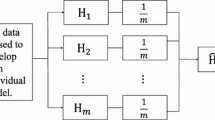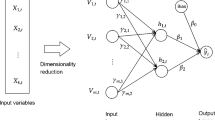Abstract
This paper presents a method of model aggregation using multivariate decompositions where the main problem is to properly identify the components that carry noise. We develop a volatility measure which uses generalized extreme value decomposition. It is applied to destructive and constructive latent component classification. A practical experiment was conducted in order to validate the effectiveness of the introduced method.
Access this chapter
Tax calculation will be finalised at checkout
Purchases are for personal use only
Similar content being viewed by others
References
Breiman, L.: Bagging predictors. Mach. Learn. 24, 123–140 (1996)
Drucker, H.: Improving regressors using boosting techniques. In: ICML, vol. 97, pp. 107–115 (1997)
Hoeting, J., Madigan, D., Raftery, A., Volinsky, C.: Bayesian model averaging: a tutorial. Stat. Sci. 14, 382–417 (1999)
Szupiluk, R., Wojewnik, P., Ząbkowski, T.: Prediction improvement via smooth component analysis and neural network mixing. In: Kollias, S., Stafylopatis, A., Duch, W., Oja, E. (eds.) ICANN 2006. LNCS, vol. 4132, pp. 133–140. Springer, Heidelberg (2006). https://doi.org/10.1007/11840930_14
Szupiluk, R., Wojewnik, P., Zabkowski, T.: Noise detection for ensemble methods. In: Rutkowski, L., Scherer, R., Tadeusiewicz, R., Zadeh, L.A., Zurada, J.M. (eds.) ICAISC 2010. LNCS (LNAI), vol. 6113, pp. 471–478. Springer, Heidelberg (2010). https://doi.org/10.1007/978-3-642-13208-7_59
Comon, P., Jutten, C.: Handbook of Blind Source Separation: Independent Component Analysis and Applications. Academic Press, Cambridge (2010)
Hyvärinen, A.: Independent component analysis: recent advances. Philos. Trans. R. Soc. A 371, 20110534 (2013)
Szupiluk, R., Wojewnik, P., Zabkowski, T.: The noise identification method based on divergence analysis in ensemble methods context. In: Dobnikar, A., Lotrič, U., Šter, B. (eds.) ICANNGA 2011. LNCS, vol. 6594, pp. 206–214. Springer, Heidelberg (2011). https://doi.org/10.1007/978-3-642-20267-4_22
Vasegi, S.V.: Advanced Signal Processing and Digital Noise Reduction. Wiley, Chichester (2008)
Evans, M., Hastings, N., Peacock, B.: Statistical Distributions, 3rd edn. Wiley, Hoboken (2000)
McFadden, D.: Modeling the choice of residential location. Transp. Res. Rec. 673, 72–77 (1978)
Author information
Authors and Affiliations
Corresponding author
Editor information
Editors and Affiliations
Rights and permissions
Copyright information
© 2018 Springer International Publishing AG, part of Springer Nature
About this paper
Cite this paper
Szupiluk, R., Rubach, P. (2018). Extreme Value Model for Volatility Measure in Machine Learning Ensemble. In: Rutkowski, L., Scherer, R., Korytkowski, M., Pedrycz, W., Tadeusiewicz, R., Zurada, J. (eds) Artificial Intelligence and Soft Computing. ICAISC 2018. Lecture Notes in Computer Science(), vol 10841. Springer, Cham. https://doi.org/10.1007/978-3-319-91253-0_24
Download citation
DOI: https://doi.org/10.1007/978-3-319-91253-0_24
Published:
Publisher Name: Springer, Cham
Print ISBN: 978-3-319-91252-3
Online ISBN: 978-3-319-91253-0
eBook Packages: Computer ScienceComputer Science (R0)




